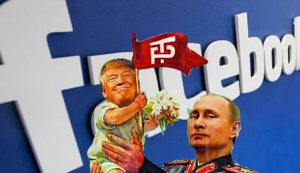Why Trump’s ominous silence about this fake news?
 In the early morning hours, Mother Jones ran one of the most important stories they’ve published since Trump invaded the White House.
In the early morning hours, Mother Jones ran one of the most important stories they’ve published since Trump invaded the White House.
Millions of tweets were flying furiously in the final days leading up to the 2016 US presidential election. And in closely fought battleground states that would prove key to Donald Trump’s victory, they were more likely than elsewhere in America to be spreading links to fake news and hyper-politicized content from Russian sources and WikiLeaks, according to new research published Thursday by Oxford University.
Nationwide during this period, one polarizing story was typically shared on average for every one story produced by a professional news organization. However, fake news from Twitter reached higher concentrations than the national average in 27 states, 12 of which were swing states—including Pennsylvania, Florida and Michigan, where Trump won by slim margins.
While it’s unclear what effect such content ultimately had on voters, the new study only deepens concerns about how the 2016 election may have been tweaked by nefarious forces on Twitter, Facebook, and other social media. “Many people use these platforms to find news and information that shapes their political identities and voting behavior,” says Samantha Bradshaw, a lead researcher for Oxford’s Computational Propaganda Project, which has been tracking disinformation strategies around the world since 2014. “If bad actors can lower the quality of information, they are diminishing the quality of democracy.” …
[D] Twitter content [cited] in the new study also contained polarizing YouTube videos–including some produced by the Kremlin-controlled RT network, which were uploaded without any information identifying them as Russian-produced. …
In studying Russia’s propaganda efforts targeting both domestic and international populations, the Oxford researchers found evidence of increasing military expenditures on social media operations since 2014. They also learned of a sophisticated training system for workers employed by Putin’s disinformation apparatus: “They have invested millions of dollars into training staff and setting targets for them,” Bradshaw says.
The full report, titled “Social Media, News and Political Information during the US Election: Was Polarizing Content Concentrated in Swing States?” and co-authored by Philip N. Howard, Bence Kollanyi, Samantha Bradshaw, Lisa-Maria Neudert, can be downloaded here.
